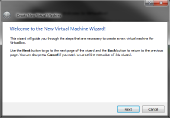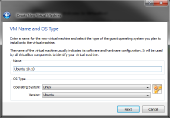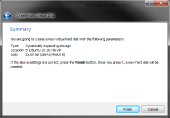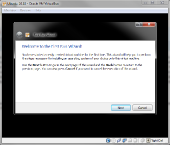Beginning the Installation
In the top left of the Virtual Box window, there is a button titled ‘New’. Click that and you should see a window like this:
This process will allow us to create a new virtual machine which will house our copy of Ubuntu 10.10. Click ‘next’ and type in the name you want Virtual Box to display for this machine. For the sake of this article I will use ‘Ubuntu 10.10’. Under ‘OS Type’ choose ‘Linux’ and then ‘Ubuntu’. This is what this windows should look like:
Go ahead and click ‘next’ again and you will be at a screen where you get to choose what you want to use for RAM. Ubuntu is usually pretty lightweight and can run on modest amounts of RAM, so we are going to set aside 512 MB for Ubuntu. The next step is a bit more involved as we need to create a virtual hard disk for the operating system to load onto. Make sure the ‘Boot Hard Disk’ radio button is checked and then check the ‘Create new hard disk’ radio and click ‘next’. A new wizard screen will pop up to guide you through creating this hard disk. Click ‘next’ and we are chosen with two options. We can either have a dynamically expanding storage space up to a certain size limit or we can choose a fixed-size storage space. The dynamic space is better if you are limited on space, however, since the cost of storage space has decreased so much most people won’t run into these issues. Click on the ‘Fixed-size storage’ radio and click ‘next’. Choose a location for this virtual drive. Since I have more than one hard drive in my machine, I am going to put mine on one of the larger drives. Now we need to choose a size for the drive. The default is 8 GB, but we are going to bump this up to 25 GB. Once you have everything set for the drive this is what the screen should look like:
Go ahead and click ‘Finish’ in the Hard Disk Creation Wizard as well as in the Virtual Machine Creation Wizard and we can finish the configuration of the virtual machine. We can now start the Virtual Machine! Go ahead and click start and you should be welcomed with a ‘First Run Wizard’. Click on ‘Next’ and the select the location where your Ubuntu ISO file is located and click on ‘Next’. The program should recognize the ISO file and once you click ‘Finish’ should boot up the virtual machine and we can begin the installation of the operating system.





http://www.virtualbox.org/manual/UserManual.html
I want to uninstall again
but im all over the place with confusion
someone want to give me the skinny?
Another tip. It will by default only give you an 800×600 virtual screen. To increase that, start Ubuntu in the Virtual machine, and then select the menu item in the virtual window (not in Ubuntu) Devices>Install Guest additions.
This mounts a virtual CD in Ubuntu, which you can auto run. This installs some extra stuff in Ubuntu. Restart Ubuntu, and you will have a larger screen.
Thanks Steven for your input! When I went to boot up the Virtual Machine for the first time after Ubuntu was installed, I never had a problem with it wanting to install again. It is a great idea however just to make sure that you don’t mess anything up. Glad to see the article was of use to you!
Thanks for this, it really got me started, and works a treat. One thing you have to do after running it the first time is change the boot order on the virtual machine, otherwise the install Ubuntu dialogue will come up each time.
To do this, go to Settings>System>Boot order. You can just un-check “CD/DVD ROM”, and from then on it will boot from the virtual HD instead of the virtual Ubuntu CD.
I have found that having a virtual linux installation makes available all the greatness of linux while allowing you to still have a user friendly OS (not to incite a flame war or anything). I once used a virtual linux installation with 10 NICs and 4 extra vnics per NIC because there were 5 gateways to link through. Why would I do this? The apt complex I lived in had a 100kb/s speed cap per IP. Quick, what is 10 NICs time 5 Gateways? The answer is 50 IPs. What is 50 * 100kb/s? A 5 MEGABYTE PER SECOND TUBE for massive torrenting greatness. Bandwidth aggregation aside, it definitely has its uses as far as development is concerned. Having both Windows and Linux available is a uniquely useful combination in the right situation.
Good article, very thorough 😉